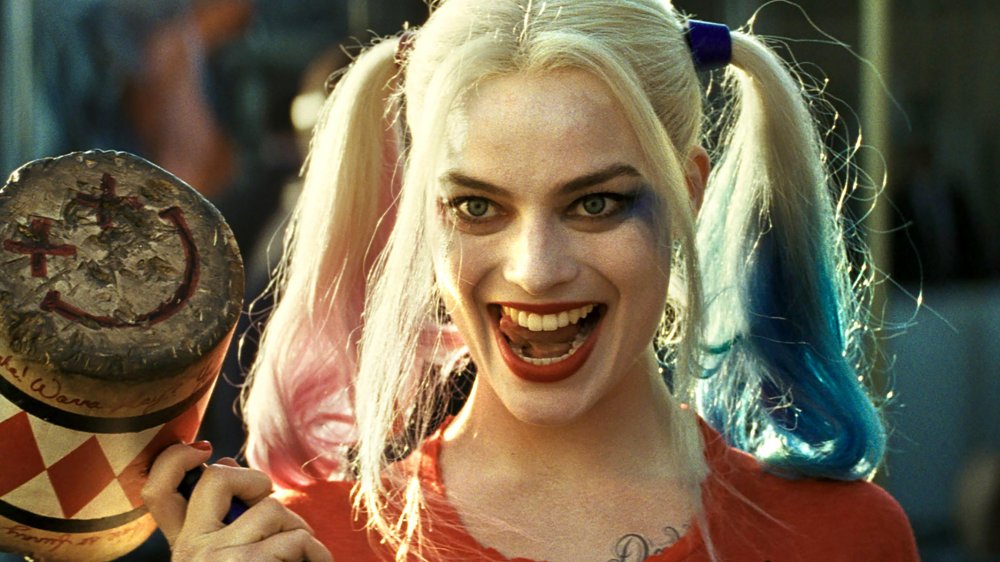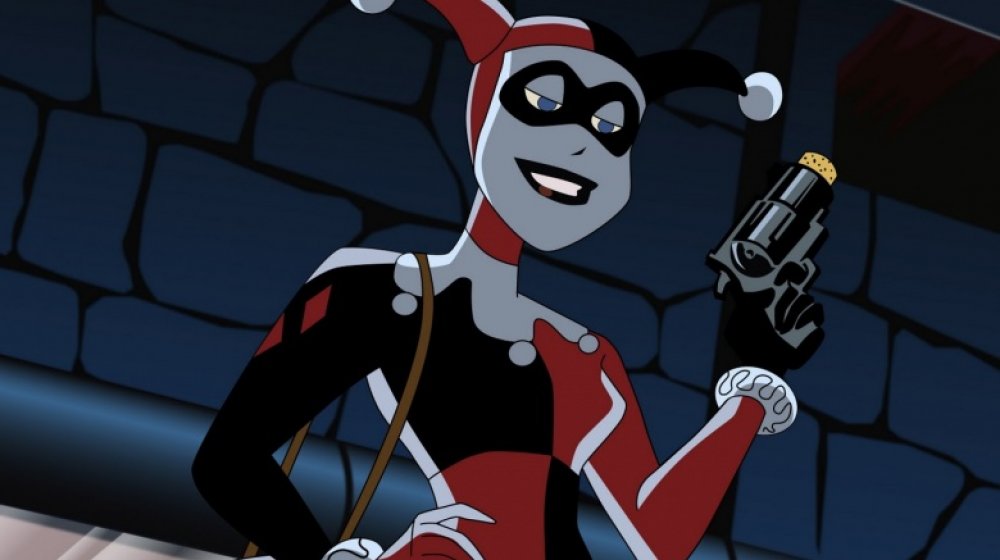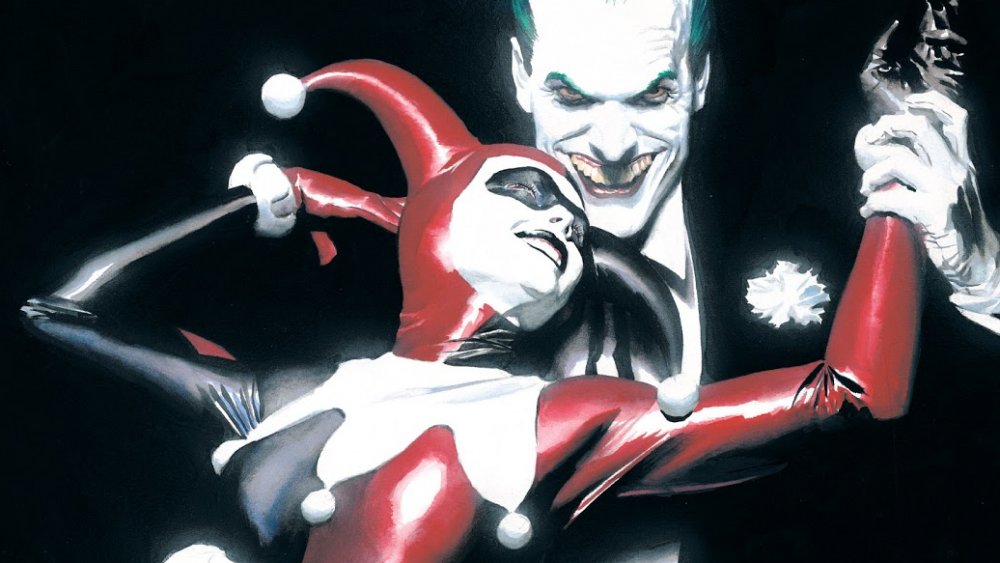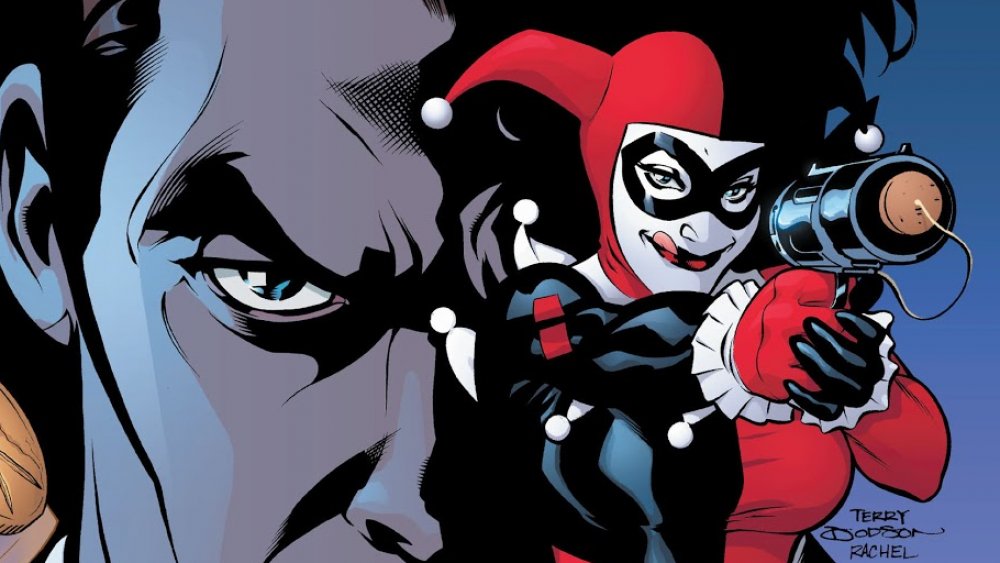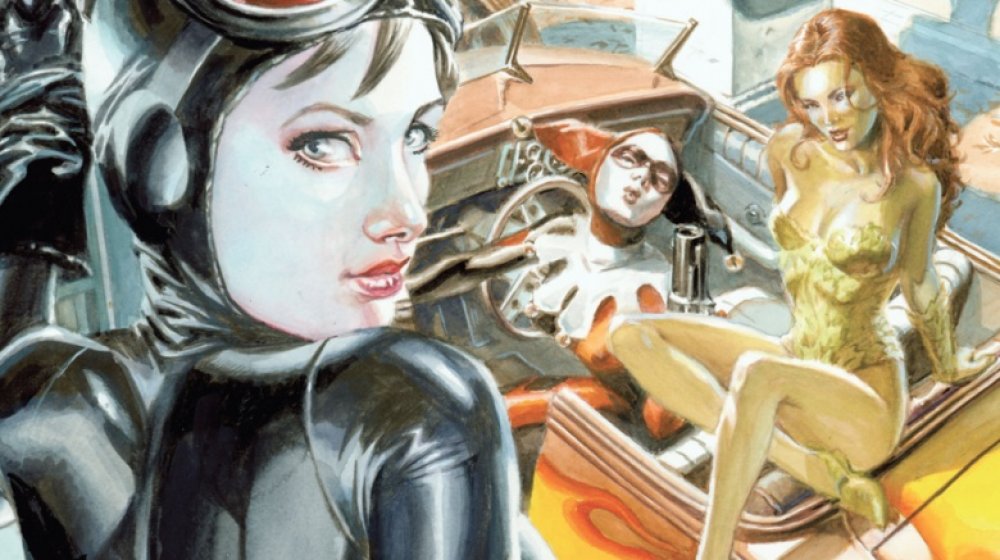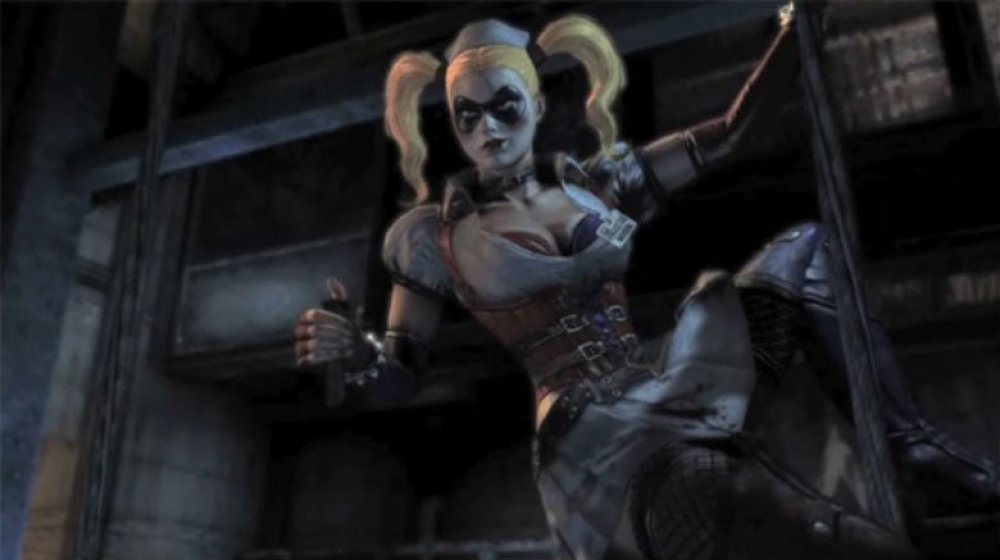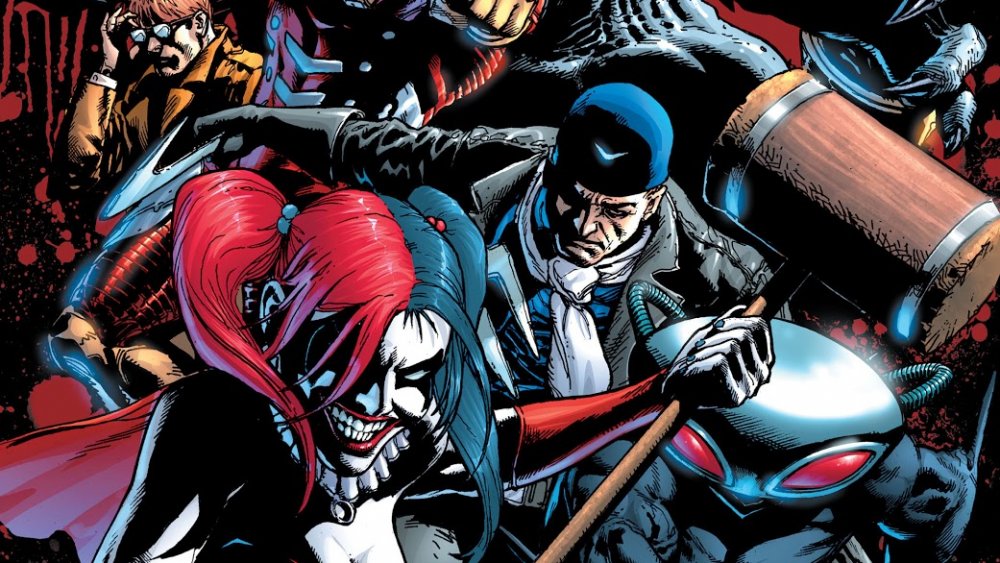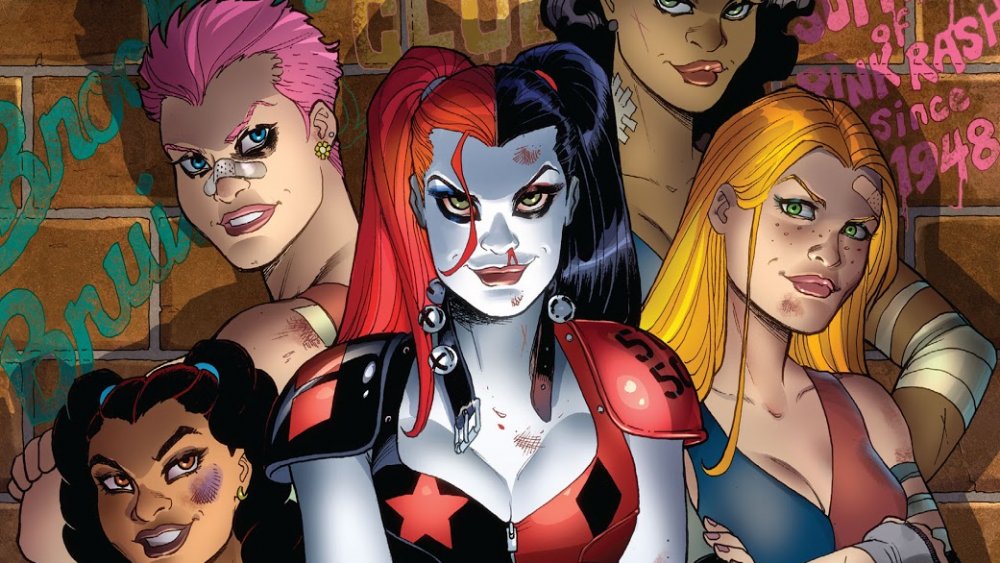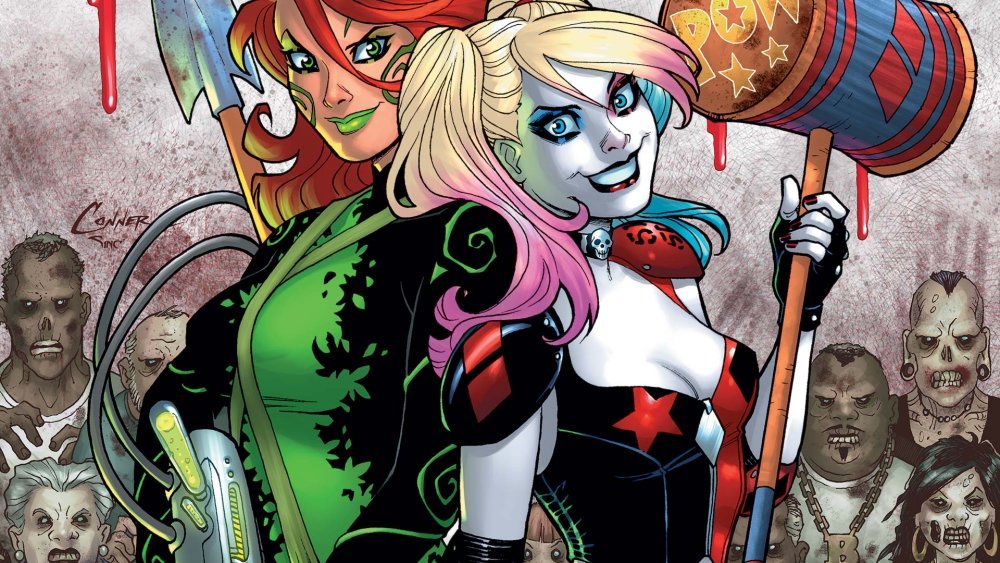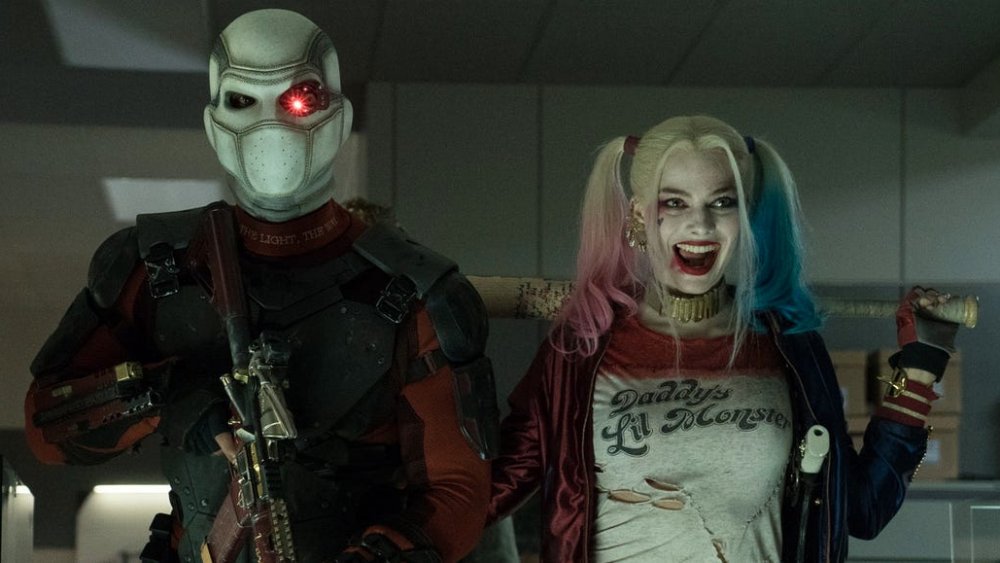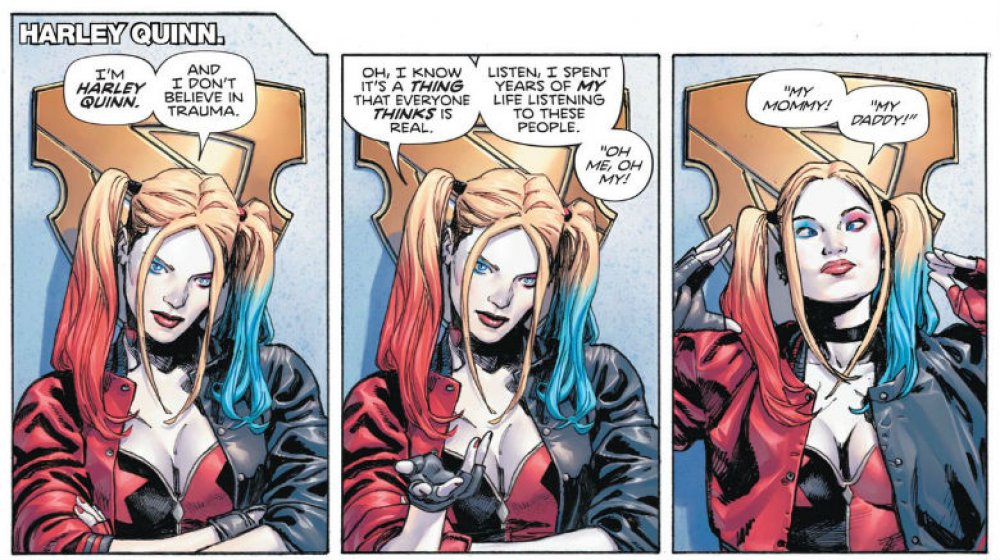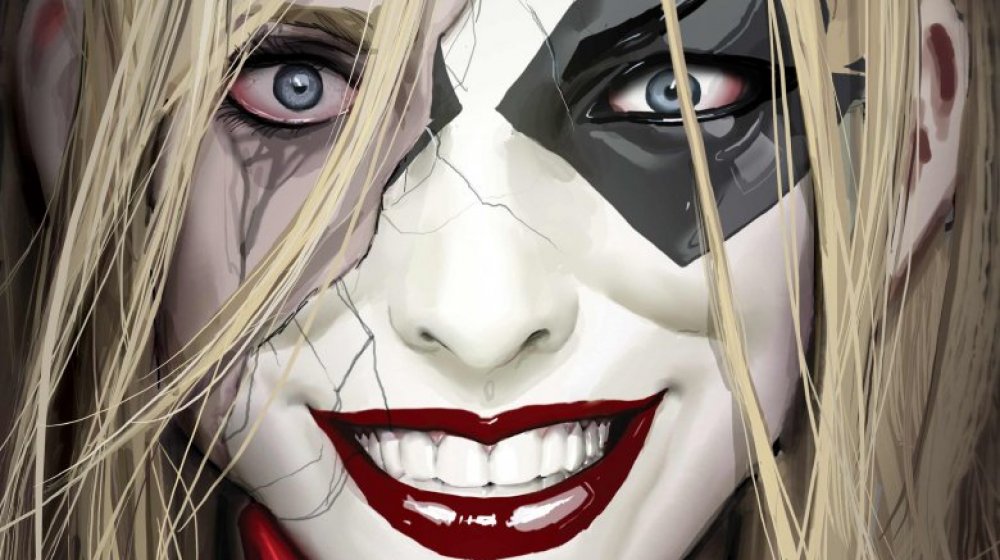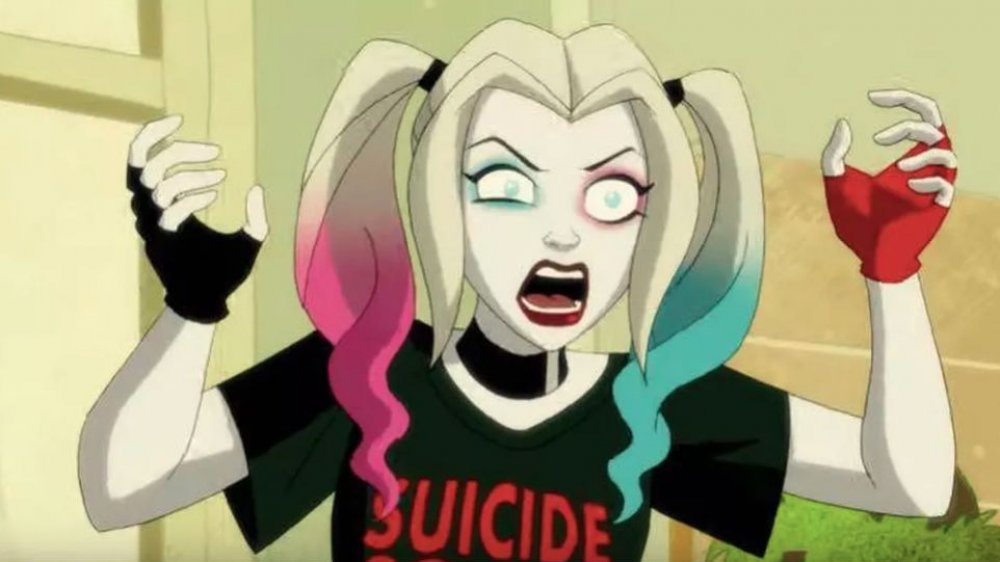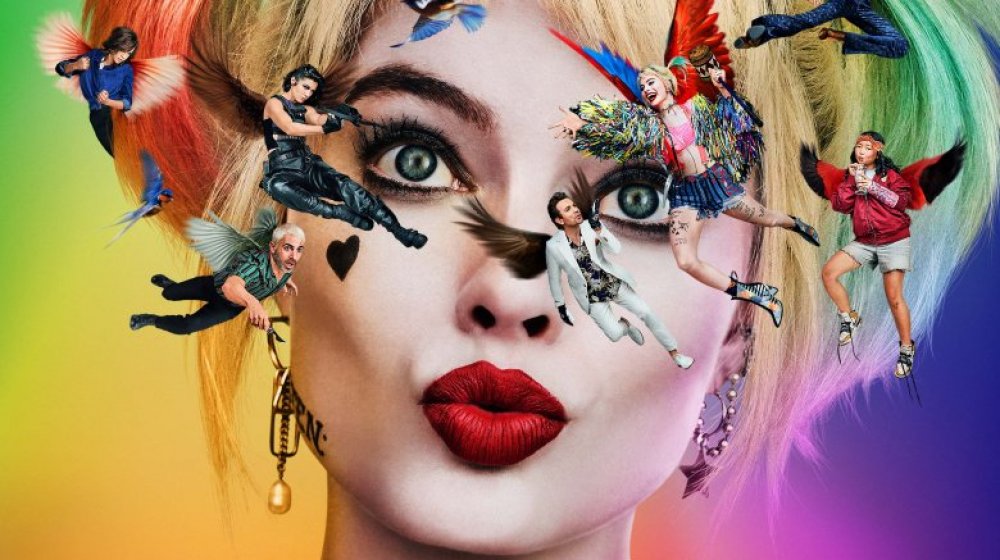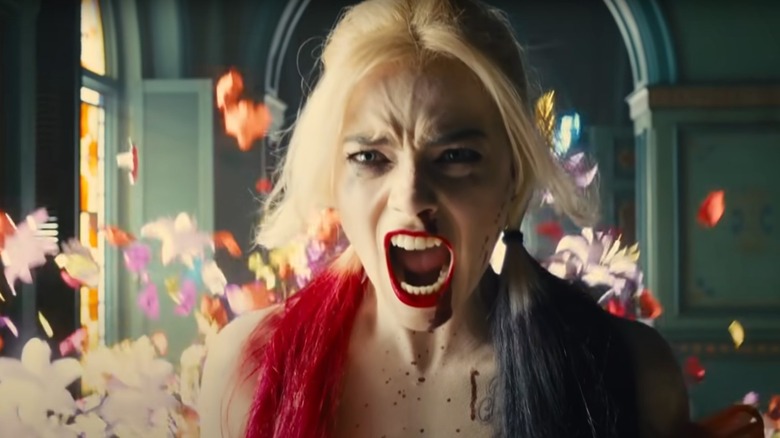The Dark History Of Harley Quinn
Sometimes, a villain is just too good to remain a villain. Comic books are filled with characters who begin their fictional lives as bad guys but — because their popularity is too much for them to remain antagonists on someone else's stage — either become so-called "anti-heroes" who walk the line between good and evil, or they just switch sides altogether. DC's Harley Quinn is the perfect example.
Over the past two and a half decades, the appeal of Harley Quinn has made it impossible for the adorable maniac to remain in the narrow confines of her conception. She was never meant to be more than a one-note Joker henchwoman in a cartoon, yet since her introduction, she's evolved to become one of the biggest players in both DC Comics and Warner Bros., on the big screen, on the small screen, and in the comics. So if you're a newcomer to Harley's gang and you want to know more about her strange and unique path, read on for the dark history of Harley Quinn.
Harley Quinn debuts in a cartoon
Harley Quinn is part of a short list of standout of comic book characters who weren't adapted from page to screen but the other way around. The character first appeared in "Joker's Favor," a 1992 episode of Batman: The Animated Series. And throughout the show, she made regular appearances as a henchwoman obsessed with the Joker, who clearly doesn't reciprocate her feelings.
Paul Dini — a writer on Batman: The Animated Series who's since gone on to write lots of other Batman-related media — conceived of Harley Quinn while watching his old college friend Arleen Sorkin on Days of Our Lives. Sorkin dressed as a jester in a dream sequence for the soap, and the scene inspired Dini to not only create Joker's twisted girlfriend but to hire Sorkin to voice her. Sorkin went on to play Quinn for numerous projects over the following decades, most recently for the online roleplaying game DC Universe Online, and she told Starlog Magazine she sees Quinn as someone who "wants to be a good girl, but it's so much more her to be a bad one."
Harley becomes part of DC Comics canon
It would take seven years after her TV debut for Harley Quinn to officially become part of the DC Comics Universe in 1999's Batman: Harley Quinn #1. Sure, Quinn appeared in comics written before 1999, most memorably in the 1994 64-page special The Batman Adventures: Mad Love, which established Harley's origin as Joker's former doctor at Arkham Asylum who becomes obsessed with her homicidal patient. But those comics were connected to the world of the animated series, and they weren't part of the larger DC Comics narrative.
Harley's first DC Comics canonical appearance came as part of the 1999 event No Man's Land, in which Gotham City is abandoned by the US government after being nearly destroyed by a massive earthquake. Like her counterpart in Mad Love, this Harley is also Joker's doctor who falls for him in a big way. She helps him escape Arkham Asylum, she's caught, and she's immediately committed. When the events of No Man's Land empty the asylum, Quinn is freed, finds her jester get-up in an abandoned costume store, and seeks out her "puddin'." Harley is as loyal as always, taking on Penguin and his goons for Joker and later going one-on-one with Batman so Joker can escape. Joker's reward is to trick her into going inside a rocket which he crashes remotely. Harley survives, and Poison Ivy finds her and nurses her back to health.
Harley Quinn strikes out on her own
The first (but not last) ongoing Harley Quinn comic premiered in late 2000. In the first issue, Harley is still under Joker's spell in spite of the abuse she's endured. After all, the Quinn-Joker relationship is incredibly complicated. But eventually, with the help of Poison Ivy, Harley manages to see enough of the real Joker to rebel against him and his henchmen. Their renewed "relationship" ends with Harley hurling the Clown Prince of Crime into a neon sign.
The series ended with 2004's Harley Quinn #38, a story that left its hero with a bleak, if not predictable, fate. After all, the writing duties changed hands from Karl Kesel to A.J. Lieberman with 2003's Harley Quinn #26, and the title grew noticeably darker under Lieberman's care. The final issue ends with Harley deciding she belongs back "home." The penultimate page shows Harley, in the pouring rain, pounding on the doors of Arkham Asylum. In the last page's final panel, Quinn's face breaks into a smile as she's led to her cell.
Harley gets some backup
In 2009, Harley Quinn made some friends. That year saw the debut of Gotham City Sirens #1, in which Harley joins forces with fellow female anti-heroes Catwoman and Poison Ivy. It all starts after Ivy saves Catwoman from a supervillain wanna-be named Bonebreaker, and she invites Selina to her new home — the apartment of the Riddler, who Ivy has rendered catatonic with her mind control abilities. And then Harley shows up shortly afterward, announcing she's moving in.
It's clear that even now, after years of abuse and attempted murder, Harley is still obsessed with the Joker. Shortly after arriving at Ivy's new pad, Harley insists she's over "Mr. J," then seconds later, she excitedly asks if he's called. By the end of the issue, the three have agreed to join forces, but they do leave Riddler's apartment for an abandoned animal shelter.
Gotham City Sirens would only last 26 issues, shuttering in 2011. But if nothing else, it was an important step in the evolution of Harley Quinn as it was the first time she appeared in an ongoing team series with other women protagonists, which is something we'd see again in 2020's Birds of Prey.
The character returns to Arkham
In August 2009, both DC fans and gamers alike were treated to Batman: Arkham Asylum. In this hit game, the player takes on the role of Batman who, after delivering Joker to the asylum, finds himself in a breakout conceived by the Clown Prince of Crime that includes classic Gotham villains like Poison Ivy, Killer Croc, and Scarecrow. In addition to Arkham's cool timeline, the game features a whole lot of talent from Batman: The Animated Series, including Kevin Conroy as Batman, Mark Hamill as the Joker, and Arleen Sorkin as Harley Quinn.
As for Harley, she appears quite a bit in the game's cut scenes, though ironically, while she's the Joker's chief lieutenant in the asylum, she's one of the only Bat-villains that players never confront physically. After sending squads of thugs after the hero, Harley is easily overpowered by Batman in a cut scene. What's perhaps most significant about Harley's spot in the game is that it's her first major appearance in media without her classic jester suit. Instead, she wears a naughty nurse outfit, sporting the twin ponytails that would become a Harley Quinn staple.
She becomes inseparable from the Suicide Squad
Believe it or not, Harley Quinn didn't appear in the first three volumes of Suicide Squad. Still, she's since become such an inseparable part of Task Force X that it's difficult to imagine there was a time when the team of blackmailed villains could function without her.
The 2011 volume of Suicide Squad that introduced Harley to the team came with DC's line-wide reboot, the New 52, at which point Harley's jester look was abandoned for black-and-red ponytails and a much skimpier outfit. Adam Glass — best known as a writer/producer on the TV series Supernatural — wrote most of the first 19 issues of the new volume, teaming Harley up with Task Force X mainstays like Deadshot and Captain Boomerang, as well as newer additions like King Shark and Diablo.
There have been two subsequent volumes of Suicide Squad since the New 52 series ended with its 30th issue, as well the short-lived New Suicide Squad, with Harley center-stage at every turn. After all, if you've got a crazy clown girl bashing people with a mallet, why not shine the spotlight on her?
The New 52 gives us a lighter, funnier Harley
Three years after the debut of the New 52, Harley had her own solo book again. This time, Harley's story was co-written by what would prove to be the fan-favorite team of Amanda Conner and Jimmy Palmiotti. And why were they so beloved by readers? Well, it's probably because the newer series had a lot more fun with its deranged antihero than the first. The series opens with Harley willed an entire apartment building on Coney Island from an old patient. Then she's joined by hilarious supporting characters like the ex-spy, geriatric cyborg Sy Borgman and the dead beaver Bernie who talks to Harley constantly in spite of his post-life status. On top of all that, she joins a roller derby team and occasionally enjoys launching hired killers off her roof with a catapult.
But Conner and Palmiotti's Harley Quinn isn't all chuckles. The series also gives us one of the most definitive splits between Harley and Joker. When Harley breaks into Arkham Asylum to free her new boyfriend in 2016's Harley Quinn #25, Joker thinks he can convince her to free him, but instead, she beats him to a bloody pulp in his cell. Holding a gun to his head and then turning away, Harley says, "I finally understand why Batman never just killed you. ... It would give you exactly whatcha want."
Harley and Ivy, sitting in a tree ...
For a long time there was speculation that Harley Quinn and fellow Gotham City anti-hero Poison Ivy were more than friends. They'd been trading innuendo and hints in comics, cartoons, and even video games for years, but it was a long time before there was any kind of official word. However, fan-favorite Harley Quinn writers Jimmy Palmiotti and Amanda Conner confirmed Harley and Ivy's relationship status in 2015. And in 2017's Harley Quinn #25 — the second volume of Harley Quinn that Conner and Palmiotti co-wrote — fans finally got to see these two share a kiss.
Sadly, Ivy's unexpected death in the 2018-19 mini-series Heroes in Crisis is part of what drives Harley over the edge and again puts her on a collision course with heroes like Batman. Thankfully, this isn't the end of Ivy ... well, technically speaking, anyway. By the end of the series, it's discovered that Ivy prepared for her death by creating a plant-based clone of herself. And as a result, Harley and the new Ivy team up for the 2019-20 Harley Quinn and Poison Ivy miniseries.
Harley Quinn hits the big screen
In 2016, Harley Quinn finally made her way to the big screen in a live-action motion picture, wielding a baseball bat and wearing some seriously short shorts in David Ayer's Suicide Squad. And of course, rising star Margot Robbie was cast in the role of the mentally unhinged Quinn after impressing critics and audiences with her performance as Naomi Lapaglia in Martin Scorsese's The Wolf of Wall Street. And amidst an ensemble cast including superstar Will Smith as Deadshot, Viola Davis as Amanda Waller, and Jared Leto as the Joker, Robbie's version of Harley was a standout.
Of course, it's no secret that as much money as Suicide Squad made for Warner Bros, it was not a favorite of critics. But even critics who couldn't stand the movie as a whole — like Chicago Tribune's Michael Phillips whose review title called the flick a "mega-stuffed superhero mess" — pointed to Robbie as an exception. Phillips wrote Robbie is "radioactively watchable" and that she sold the movie with "wide-eyed enthusiasm."
Harley Quinn: Hero in Crisis
In the 2018-19 mystery drama mini-series Heroes in Crisis, Harley wasn't only a hero but also one of the suspects. And yeah, big SPOILERS for that series are inbound, so read at your own risk.
In the first issue, we learn that over a dozen superheroes have been murdered at Sanctuary, a place for superheroes in need of emotional recovery. Most of the victims are obscure types, but a few — like Poison Ivy and Green Arrow's old sidekick, Arsenal — rise above the C-list. Harley Quinn and Booster Gold appear to be the only survivors of the event, and we're led to believe one of them must be the killer. By the end of the series, we learn the deaths were accidental and that the heroes were caught in the wake of the Wally West Flash unleashing his powers during an emotional breakdown.
But before the truth is revealed, Harley — heartbroken over the loss of Poison Ivy — reverts to her old form. She briefly returns to her old jester outfit and, when cornered, miraculously outwits and escapes the unbeatable trio of Batman, Superman, and Wonder Woman. By the end of Heroes in Crisis, we learn Ivy actually prepared for her death by creating a plant-based clone of herself, and this new Ivy and Harley embark on a new adventure in the 2019-20 mini-series Harley Quinn & Poison Ivy.
DC Black Label offers new takes on Harley
In early 2018, DC Comics announced the launch of its Black Label imprint. DC Black Label promised to give "premiere talent" the opportunity to tell standalone stories "outside of the current DC Universe continuity." This freedom allows creators to tell exactly the stories they want to tell — even going so far as killing off marquee DC characters — without worrying about impacting the standard DC narrative. And as you might've guessed, Harley Quinn has already proven to be the star of two of the imprints' miniseries, with Harleen and Joker/Harley: Criminal Sanity.
Joker/Harley: Criminal Sanity, by writer Kami Garcia and artists Mico Suayan and Mike Mayhew, reframes Harley's origin. Instead of beginning her comic book life as Joker's doctor in Arkham Asylum, the Harley of Criminal Sanity is instead a criminal profiler assisting the Gotham PD in tracking down a killer. Meanwhile Stjepan Šejić's Harleen gives us the more familiar Dr. Harleen Quinzel of Arkham Asylum, but Šejić takes us on a steady, intriguing trip to show exactly how the flawed Dr. Quinzel could become so tragically obsessed with the Joker.
She blazes her own path in an animated series
If you were thinking — what with multiple versions of Harley Quinn appearing in ongoing comics, Suicide Squad, and Birds of Prey — that DC was done with injecting as much Harley as it could into the pop culture scene, you'd be wrong. In late 2019, the new Harley Quinn animated series premiered on the DC Universe streaming service, and ho-boy, is it a unique spin on the character.
Harley Quinn follows the titular anti-hero as she tries to make a name for herself in the ranks of supervillainy after finally dumping her abusive boyfriend, Joker. The show is often a merciless, hilarious spoof on the Gotham City mythos, and the crew that Harley forms is a reflection of that. There's Clayface, who's more drama geek than bad guy and spends more time concocting the motivations of the people he disguises himself as than committing crimes. There's also King Shark, who resents being seen as a killer (even as he bites security guards' heads off) and identifies more as tech support. And of course, there's Doctor Psycho, who's really just as disgusting as he is in the comics.
Her best friend Poison Ivy is there too, pushing her from the beginning to forget the manipulative Joker.
Harley leads the Birds of Prey
In 2020, fans had the chance to see Margot Robbie reprise the role of Harley in Birds of Prey (and the Fantabulous Emancipation of One Harley Quinn).
The film takes place after a bad break-up between Harley and the Joker, and like the DC Universe animated series Harley Quinn, our heroine is now on a quest to make her own way in the world without being in the Clown Prince of Crime's shadow. She's joined by a number of mainstays from DC's mythos like Jurnee Smollett-Bell as Black Canary, Mary Elizabeth Winstead as Huntress, Rosie Perez as former Gotham cop Renee Montoya, and Ella Jay Basco as Cassandra Cain. Joker doesn't appear in the film in person, and instead, Harley and her new allies face Ewan McGregor as crime lord Black Mask.
The Birds of Prey have had a number of series over the years, and they even had their own short-lived television series in the early aughts. However, Harley's addition to the team and her prominence in the line-up is one of the biggest departures from the Birds of Prey comics. In fact, on the page, she has pretty much nothing to do with the crew at all.
Harley Quinn returns to The Suicide Squad
When it was announced that James Gunn would be writing and directing The Suicide Squad — the sequel, soft reboot, or reinvention of Suicide Squad, depending on who you ask — rumors started flying about who would or wouldn't reprise their roles in the casualty-heavy Task Force X. In February 2019, Forbes claimed Harley Quinn had been jettisoned from the drawing board. But a week later, Forbes writer Mark Hughes wrote a correction, saying he'd since learned Robbie was set to return to Amanda Waller's captive anti-heroes.
For most of 2019, there was no confirmation either way whether Harley Quinn would be bringing her mallet and her homicidal joy back to the Suicide Squad. But finally, in September 2019, Gunn shared a picture listing every name in the principal cast of The Suicide Squad, including Margot Robbie's.
The Suicide Squad released in 2021 and received much higher reviews than the previous Suicide Squad attempt. In a review for the movie, RogerEbert.com noted, "Robbie knows Quinn inside and out by this point, and it feels like Gunn returns her a bit more to her origins (even just in color palette) than [director David Ayer]."
